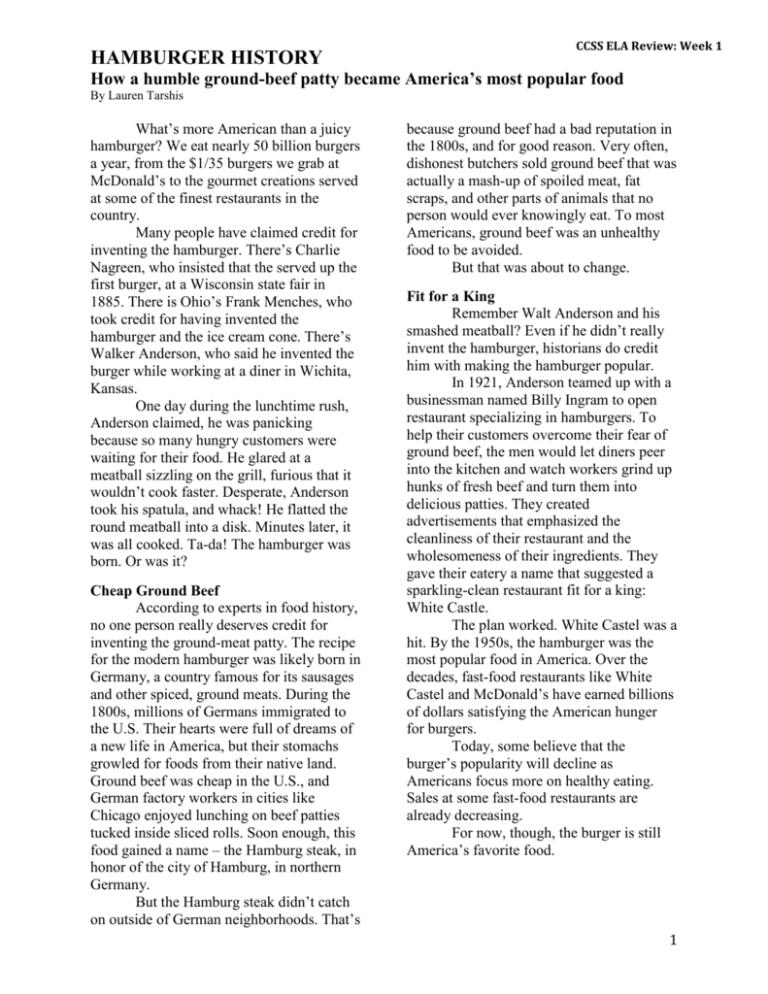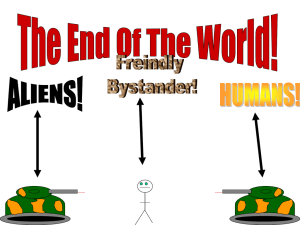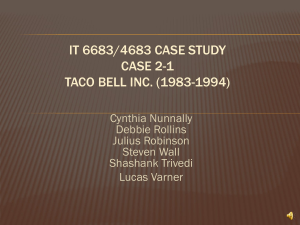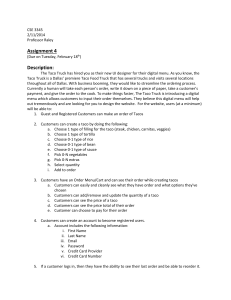Week 1 - Hamburger - Dr. Thao
advertisement

HAMBURGER HISTORY CCSS ELA Review: Week 1 How a humble ground-beef patty became America’s most popular food By Lauren Tarshis What’s more American than a juicy hamburger? We eat nearly 50 billion burgers a year, from the $1/35 burgers we grab at McDonald’s to the gourmet creations served at some of the finest restaurants in the country. Many people have claimed credit for inventing the hamburger. There’s Charlie Nagreen, who insisted that the served up the first burger, at a Wisconsin state fair in 1885. There is Ohio’s Frank Menches, who took credit for having invented the hamburger and the ice cream cone. There’s Walker Anderson, who said he invented the burger while working at a diner in Wichita, Kansas. One day during the lunchtime rush, Anderson claimed, he was panicking because so many hungry customers were waiting for their food. He glared at a meatball sizzling on the grill, furious that it wouldn’t cook faster. Desperate, Anderson took his spatula, and whack! He flatted the round meatball into a disk. Minutes later, it was all cooked. Ta-da! The hamburger was born. Or was it? Cheap Ground Beef According to experts in food history, no one person really deserves credit for inventing the ground-meat patty. The recipe for the modern hamburger was likely born in Germany, a country famous for its sausages and other spiced, ground meats. During the 1800s, millions of Germans immigrated to the U.S. Their hearts were full of dreams of a new life in America, but their stomachs growled for foods from their native land. Ground beef was cheap in the U.S., and German factory workers in cities like Chicago enjoyed lunching on beef patties tucked inside sliced rolls. Soon enough, this food gained a name – the Hamburg steak, in honor of the city of Hamburg, in northern Germany. But the Hamburg steak didn’t catch on outside of German neighborhoods. That’s because ground beef had a bad reputation in the 1800s, and for good reason. Very often, dishonest butchers sold ground beef that was actually a mash-up of spoiled meat, fat scraps, and other parts of animals that no person would ever knowingly eat. To most Americans, ground beef was an unhealthy food to be avoided. But that was about to change. Fit for a King Remember Walt Anderson and his smashed meatball? Even if he didn’t really invent the hamburger, historians do credit him with making the hamburger popular. In 1921, Anderson teamed up with a businessman named Billy Ingram to open restaurant specializing in hamburgers. To help their customers overcome their fear of ground beef, the men would let diners peer into the kitchen and watch workers grind up hunks of fresh beef and turn them into delicious patties. They created advertisements that emphasized the cleanliness of their restaurant and the wholesomeness of their ingredients. They gave their eatery a name that suggested a sparkling-clean restaurant fit for a king: White Castle. The plan worked. White Castel was a hit. By the 1950s, the hamburger was the most popular food in America. Over the decades, fast-food restaurants like White Castel and McDonald’s have earned billions of dollars satisfying the American hunger for burgers. Today, some believe that the burger’s popularity will decline as Americans focus more on healthy eating. Sales at some fast-food restaurants are already decreasing. For now, though, the burger is still America’s favorite food. 1 CCSS ELA Review: Week 1 TACOS TAKE OVER How a Mexican food became an American classic By Lauren Tarshis It was 1951 in San Bernardino, California, and 28-year-old Glen Bell was grilling up burgers and hotdogs at his little roadside stand, Bell’s Drive-In. For weeks, Bell had been peering out the kitchen window at the restaurant across the street, the Mitla Café. Bell’s place was always bustling, but Mitla’s was packed. During most lunch times, people were lined up around the corner waiting for a table. What was happening in there? Finally, Bell just had to see what the fuss was about. He went to Mitla’s and stood in line, the only white person in a crowd of mostly Mexican immigrants. He was warmly welcomed and served the house specialty: a taco. Few non-Hispanic Americans had ever tasted this Mexican treat, a fried corn tortilla shell stuffed with meat and cheese and topped with a spicy tomato sauce. Bell picked up the taco, breathing in the delicious scent. He took his first bite. Crunch. Bell almost fell off his chair in ecstasy. Not only had he discovered his new favorite food. He had just tasted his future. A Taste of Home California shares a border with Mexico, and for decades Mexican immigrants had been pouring into Southern California cities, bringing with them recipes for their favorite dishes. In many MexicanAmerican neighborhoods, the air was thick with the aroma of meats spiced with dried chile peppers, woodsy cumin, and chocolate-tinged mole [MOH-lay] sauces. By the 1950s, there were dozens of small restaurants like Mitla’s, modest joints serving up tacos and other dishes for Mexicans longing for a taste of home. Non-Hispanic Americans rarely ventured into these Mexican restaurants. Most Americans were not adventurous eaters; many feared that Mexican food would be too spicy, or that it would make them sick. But Bell sensed that Americans might be ready for something new. And was the taco really so exotic? Americans already used ground beef in their hamburgers. Wasn’t the taco shell a little bit like a hamburger bun? And was taco sauce so different from ketchup? Bell became determined to introduce his favorite food to a wide American audience and started making plans to open his own taco stand. His first challenge was to speed up the process for preparing tacos, to satisfy the American craze for “fast food.” It was no problem to prepare the beef fillings in advance. But each taco shell had to be fried moments before serving, or else it became soggy. Bell spent his evenings experimenting in his home kitchen, finally devising a method for making taco shells that could be crisped up in advance. He concocted a taco sauce that was less spicy than a typical piquant Mexican sauce. He designed his taco place to be modern, more like a fast-food restaurant than a homey Mexican taco stand. Bell’s first taco restaurant, Taco Tia, opened in 1954 and was an immediate success. As Bell had hoped, most of his customers were new to tacos and thrilled with his milder fast-food version. Within the year, he had opened two more restaurants. By 1962, he had sold Taco Tia and founded the fast-food chain Taco Bell. Today, there are more than 5,500 Taco Bell restaurants in the U.S., with thousands more around the world. Over the years, some have criticized Glen Bell for “Americanizing” Mexican food too much. But even critics agree that he succeeded in introducing Mexican food to picky Americans and helped to make the taco as popular in the U.S. as apple pie. 2 CCSS ELA Review: Week 1 Compare & Contrast Directions: Answer the questions in the left-hand column for both hamburgers and tacos. Then check the appropriate box to indicate whether the answers are similar or different, or a bit of each. After completing the chart, respond to the writing prompt at the bottom of the page. Hamburgers Tacos Similar Different What group of people first made and ate this food in America? Why did most Americans stay away from this food at first? Who made this food popular in America? Was the food changed so that Americans would like it? If so, how? What made the new restaurants that served this food appealing to Americans? Is the food still popular today? You Write It! Now you are ready to complete the writing prompt. What is similar about how the hamburger and the taco became popular in the U.S.? What is different? Write your answers in two well-organized paragraph, using evidence from the texts. 3 CCSS ELA Review: Week 1 “Hamburger History” & “Tacos Take Over” Directions: Read the articles “”Hamburger History” and “Tacos Take Over.” Then fill in the bubble next to the best answer for each question below. 1. Which of the following is the main idea of “Hamburger History”? a. Several people have claimed credit for inventing the hamburger. b. Walt Anderson and White Castle made hamburgers popular. c. Burgers are the most popular food in Germany. d. People like to watch food being made. 5. In what way did hamburgers contribute to the popularity of tacos in the U.S.? a. Before hamburgers became popular, few Americans were willing to eat ground beef. b. Before hamburgers became popular, few Americans ate tomato sauce. c. Burgers made spicy food popular. d. Burgers made cheese popular. 2. Which line from the article supports the answer to question 1? a. “What’s more American than a juicy hamburger?” b. “He flattened the round meatball into a disk.” c. “The hamburger was born.” d. “White Castle was a hit.” 6. Both articles tell you __________. a. the name of a city in Germany b. how foods from other countries became popular n the U.S. c. why ground beef was once seen as unhealthy d. ingredients in a taco 3. Walt Anderson named his restaurant White Castle to show that it was _________. a. large b. very expensive c. clean and high-quality d. very old 4. “Tacos Take Over” says that Glen Bell “almost fell off his chair in ecstasy” the first time he tasted a taco. In other words, he … a. was amazed at how good the taco tasted. b. was shocked by how spicy it was. c. was surprised by how popular tacos were. d. thought the taco was almost as good as a burger. 7. “Tacos Take Over” shows that Glen Bell’s idea for a fast-food taco restaurant was __________. a. a success b. a failure c. nothing new d. quickly forgotten 8. Which sentence from the article supports the answer to question 7? a. “What was happening in there?” b. “And was the taco really so exotic?” c. “He took his first bite.” d. “Within the year, he had opened two more restaurants.” 9. Both Walt Anderson and Glen Bell made unfamiliar foods popular. In what way were their methods similar? 10. Some people have criticized Glen Bell for “Americanizing” Mexican food. Why might that be considered a bad thing? 4 CCSS ELA Review: Week 1 ANSWER KEY Compare & Contrast Directions: Answer the questions in the left-hand column for both hamburgers and tacos. Then check the appropriate box to indicate whether the answers are similar or different, or a bit of each. After completing the chart, respond to the writing prompt at the bottom of the page. Hamburgers Tacos Similar What group of people first made and ate this food in America? German immigrants Mexican immigrants X Why did most Americans stay away from this food at first? Americans thought ground beef was unhealthy. Americans thought they would be too spicy or make them sick. X Walt Anderson and Billy Ingram Glen Bell Was the food changed so that Americans would like it? If so, how? Yes. The ground beef was fresh and wholesome. Yes. The sauce was made less spicy. What made the new restaurants that served this food appealing to Americans? Customers could get their food quickly. Customers could get their food quickly. The restaurant had a name that suggested The restaurant looked like other modern cleanliness and royalty. fast-food places. X Yes X Who made this food popular in America? Is the food still popular today? Yes Different X X X You Write It! Now you are ready to complete the writing prompt. What is similar about how the hamburger and the taco became popular in the U.S.? What is different? Write your answers in two well-organized paragraph, using evidence from the texts. 5 CCSS ELA Review: Week 1 ANSWER KEY “Hamburger History” & “Tacos Take Over” Quiz 1. 2. 3. 4. 5. 6. 7. 8. 9. 10. B (main idea; R.2) D (text evidence; R.1) C (key detail; R.1) A (vocabulary; R.4) A (synthesizing; R.7) B (compare and contrast; R.9) A (main idea; R.2) D (text evidence; R.1) Both men created restaurants that would appeal to their customers and make them more at ease with unfamiliar food. Anderson emphasized cleanliness, and Bell created an Americanstyle fast-food restaurant. Bell also adjusted his recipe to make tacos seem more similar to foods non-Hispanic Americans were already familiar with. (synthesizing/compare and contrast; R.9) Answers will vary. Students might say that “Americanizing” Mexican food could give Americans an inaccurate idea of what Mexican food is like and might imply that authentic Mexican food isn’t good enough as it is. (inference; R.1) 6







